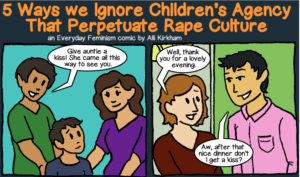Panel 1
(An historian sitting in an office, with a book on the desk, a globe, and a chalkboard listing colonial locations and various dates behind them.)
Historian: Columbus Day is a time to reflect on the history of our nation (or it has been since being established as a federal holiday during World War II). Since they say that history is written by the victors, let’s take a look at what some of the early European colonizers had to say about how colonization worked in their own words.
Panel 2
(Christopher Columbus standing on the deck of a ship, looking proud. Below him is an aged-looking scroll with his words written on it.)
Columbus: I’m Christopher Columbus. I sailed to the New World four times. Two years into my second expedition, a quarter of a million Natives had died as a result of me forcing them to work in gold mines, chopping off their hands if they didn’t perform to my standards, and my men’s use of girls as young as nine as sex slaves.
Text: “To speak, in conclusion, only of what has been done during this hurried voyage, their Highnesses will see that I can give them as much gold as they desire, if they will give me a little assistance, spices, cotton, as much as their Highnesses may command to be shipped, […] and as many slaves as they choose to send for, all heathens.” —from a letter to Luis de Sant Angel announcing his discovery
Panel 3
(Bartolomé de las Casas in a priest’s robes holding a rosary and looking contrite, standing in a stone-walled room in front of a desk. Below him is an aged piece of parchment with his words on it.)
de las Casas: My name is Bartolome de las Casas, and I was so concerned about the extermination of the Taino being perpetrated by Spanish colonizers that I was the first advocate for the importation of African slaves. So I’m directly responsible for the more than twelve million Africans enslaved and/or killed as a result of the Atlantic slave trade.
Text: “[The Spaniards] took infants from their mothers’ breasts, snatching them by the legs and pitching them headfirst against the crags or snatched them by the arms and threw them into the rivers, roaring with laughter and saying as the babies fell into the water, ‘Boil there, you offspring of the devil!’ ” –from “A Brief Account of the Devastation of the Indies”
Panel 4
(Álvar Núñez Cabeza de Vaca wearing rags, with a scruffy beard, standing in front of an empty desert. Below him are some tattered pages with his words written on them)
Cabeza de Vaca: I’m Álvar Núñez Cabeza de Vaca – I got lost on the North American continent and encountered dozens of unique cultures that I observed and reported on. Almost all of those cultures were leery of Spaniards because, in spite of the fact that the King, Queen, and Pope had expressly forbidden the enslaving of indigenous populations, Spanish Slavers still forced thousands of Natives into slavery.
Text: “We found many people there collected out of fear of the Christians. […] The tracks of the Christians and marks where they slept were continually seen. At mid-day we met our messengers, who told us they had found no Indians, that they were roving and hiding in the forests, fleeing that the Christians might not kill nor make them slaves; the night before they had observed the Christians from behind trees, and discovered what they were about, carrying away many people in chains.” —from “The Relation”
Panel 5
(John Smith with his hands on his hips holding a bandage across his crotch, standing on the deck of a ship with Virginia fading in the background. Below him is a weather-beaten journal with his words written in it.)
Smith: I’m John Smith – I was paid by a corporation to profitably colonize the new world and I was good at it; I even had a damned decent plan to take care of all those natives in Virginia, though a lot of my work had been done for me by the smallpox epidemic spread by the Spaniards. It killed millions of Natives before I showed up – making my job so much easier.
Text: “Four thousand [men would be enough], to [destroy the Savages.] In the depth of Winter we might burn all the houses upon all those Rivers […] then without fires they could not live, [nor could they hide, and we could so exhaust them by hunting them that] they would be so weary of their lives, as [to] either fly all their Countries, or give all they had to be released of such an hourly misery” —from “How to Subject all the Savages in Virginia” from The General History of New England by John Smith
Panel 6
(The historian’s office, the historian is holding up the book from their desk and looking concerned.)
Historian: Look, I get it. You want to celebrate achievement, appreciate your country and teach the concept of noble exploration to kids. You want your history, the history written by the victors, to be something to be proud of. But it isn’t. And before you call out “revisionist” and “political correctness,” look at those people’s words.
Panel 7
(The historian has set the book down and is gesturing at the board)
Historian: John Smith cheerfully enslaved thousands to pay back a small debt and made up a plan to destroy their homes and drive them away – Smith is, by the way, lauded by history for his fair handling of Natives. Columbus called for enslaving hundreds of thousands of people. He’s often excused by historians because of bankruptcy, but his plans to enslave Native populations were written out in this letter from 1493. These are your victors, this is your history – one of disease and murder and rape and genocide.
Panel 8
(The historian leaning against their desk over the closed book.)
Historian: It is time to stop pretending that a Genoan slave-trader and social climber was a noble lone explorer. Columbus’ voyages were tremendously important to the Spanish Empire and the Taino people, but we only hear about him from the perspective of the Spanish Empire, not from the perspective of the murdered Taino. If you’re going to teach the history, teach it right. Include voices beyond the voices of power. And happy International Day of Solidarity with Indigenous People.





















